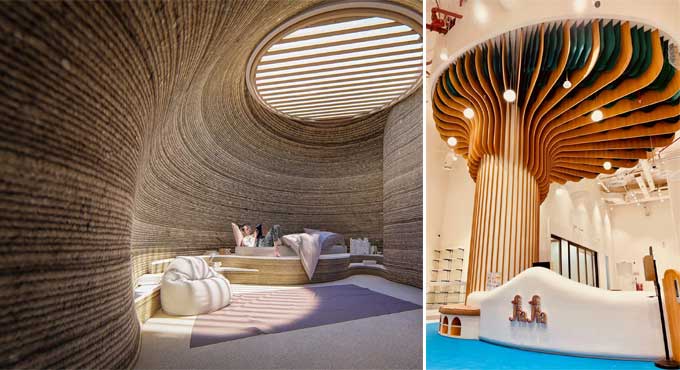Why are Architectural Companies using 3D Printing in the Interior Design Industry?
Tweet
A layer by layer construction process enables digital 3D models to be converted into physical objects using 3D printing. With the technology, designers can be creative, prototyping can be done more quickly, and customization can be done more easily. In addition, the use of eco friendly and waste reduction materials in 3D printing promotes sustainability.
As a result, interior design firms are able to produce unique designs while maintaining intellectual property with improved efficiency, cost effectiveness, and quality. Through 3D printing, firms can realize their innovative design visions and enhance customer satisfaction.
Define 3D Printing
While 3D printing has transformed the interior design industry significantly, using software for home product design is not new. It allows digital designs to be converted into tangible, custom-made objects.
Today, 3D models can be created from a variety of products, enabling designers to obtain impressive levels of accuracy and customization. By adding material layer by layer, 3D printing differs from conventional manufacturing methods. In this way, highly customized products can be produced in a way that is specifically tailored to satisfy the needs of individual customers.
A customized bed frame can provide greater comfort for people with a non standard leg length, as well as furniture and other home items tailored to their unique measurements.
Benefits of 3D Printing in Interior Design
Excessive Features
The technology of 3D printing has revolutionized interior design by allowing designers to express themselves in a way that was never before possible. With traditional manufacturing limitations no longer present, designers are free to explore and experiment with their designs. The use of 3D printing makes it possible to design furniture with innovative patterns and designs that will stand out from the crowd.
Eco Friendly
It is easy to visualize and bring to life the concepts interior designers and their clients envision with the aid of 3D printers. It can create items to be 3D printed & energy-efficient and require minimal materials. By reducing material waste and energy consumption, 3D printers promote eco friendly practices. As a result, creative concepts can become tangible realities using 3D printing.
Cost Effective
Interior design projects can benefit significantly from 3D printing solutions. Because 3D printing is precision based, there is very little waste material, which reduces the amount of labor and time required. Using biodegradable materials will also decrease the environmental impact of the project.
3D printing eliminates the need for inventory storage and associated costs. While promoting sustainability, 3D printing reduces the overall cost of design projects by minimizing waste, labor, and storage expenses.
Customer Satisfaction
With 3D printing, the interior design industry can maintain confidentiality, reduce production costs, offer on-demand manufacturing, achieve design flexibility, & achieve creative freedom.
Design in No time
A long process of manually crafting samples to present to clients is no longer necessary for interior design companies. This aspect of the design process has been revolutionized by rapid prototyping through 3D printing.
Design software provides designers with the ability to upload their designs to a computer and wait for them to be converted into 3D models by the machine.
In comparison to traditional manual crafting, 3D printing takes considerably less time to create the digitally sculpted shape. 3D printing saves time that can be better utilized for discussing the proposed layout with clients.
The mini 3D structure allows clients to understand better & visualize the proposed design, which leads to collaborative & informative decision making.
Unique Design
You can create unique 3D printed designs with the user friendly software associated with modern 3D printers. The use of 3D printing allows you to demonstrate your artistic vision while meeting the needs of your clients.
The versatility and freedom of 3D printing allows you to design custom furniture models or create unique interior aesthetics that blend the client's desires and your creative vision.
Flexible & Effective Design Process
Using 3D printing solutions in interior design provides designers with unparalleled creative freedom. In addition, 3D printing facilitates faster project completion, improving efficiency. In just a few hours, accurate 3D models can be created with minimal effort and cost, thereby facilitating communication between clients and designers.
With 3D printed models, designs can be reviewed and evaluated more effectively due to their high level of accuracy. Therefore, the design phases can be shortened, resulting in a more efficient process overall.
The final design can be easily visualized and assessed by the client, facilitating alignment and ensuring that everyone shares the same vision. 3D printing enables clients and designers to collaborate and make informed decisions while saving time and money.
Build More Copies
Through 3D printing, interior design companies can produce several versions of their final production model conveniently. 3D printed images can also be stored online for future reference for possible 3D printing.
To get online demonstration, watch the following video tutorial.
Video Source: Formlabs
Conventional methods of building 3D models do not allow for quick creation of several copies. A scale model replica of an interior designer's product can be presented to potential partners and customers alike.
Confidentiality
Achieving confidentiality is essential in architectural design when creating custom design elements and spaces. Your unique designs are protected by in-house measures that prevent third parties from copying them. Your intellectual property can be protected from unauthorized use or disclosure when you conduct these processes in-house.

Gallery
Feel free to contact us for BIM requirements. One of our representative will respond you within 24 Hours. Send us your projects requirement today and grow your project.
Explore More !







